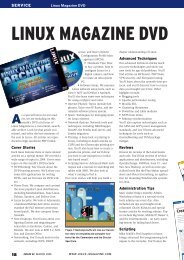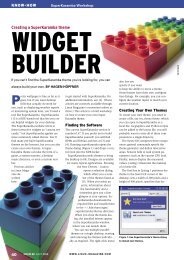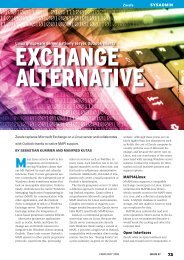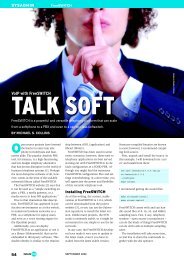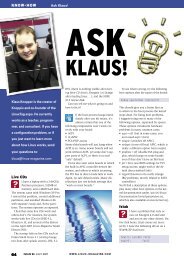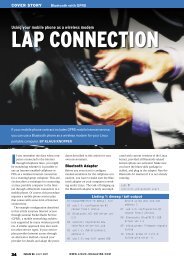You also want an ePaper? Increase the reach of your titles
YUMPU automatically turns print PDFs into web optimized ePapers that Google loves.
COVER FEATURE NOTEBOOK GROUP TEST<br />
TOSHIBA<br />
TECRA 8100<br />
AND<br />
SATELLITE<br />
PRO 4300<br />
42 LINUX MAGAZINE 5 · 2001<br />
Toshiba is known for its robust and well<br />
manufactured notebooks. For this test we<br />
borrowed a machine from the top-of-the-range<br />
Tecra series and one from the company's Satellite<br />
Pro range.<br />
We'll start with the little brother of the big bold<br />
Tecra – the Satellite Pro 4300. This comes into the<br />
high-end notebook category and is designed to<br />
replace a desktop PC. Accordingly, the disk drive<br />
and 8x DVD-ROM are permanently installed.
The plastic case is conventional in design but we<br />
would have liked an Ethernet connector as well as a<br />
line output from the sound card. However, Toshiba<br />
has added a reset button which is recessed into the<br />
case and has to be pressed using a pointed object<br />
such as a pen. The grille protection on the side air<br />
vent seemed a little delicate – it's merely a plastic<br />
cross just under a millimetre thick. Even a forgotten<br />
biro could easily penetrate it during transport in a<br />
carrying bag.<br />
You won't need external speakers because two<br />
excellent and large loudspeakers have been installed<br />
in the Satellite Pro directly above the keyboard.<br />
These can make a fair old din if you want them to.<br />
Toshiba Tecra 8100<br />
The design of the Toshiba Tecra 8100 is, apart from<br />
the keyboard and mouse which are identical to the<br />
Satellite Pro, completely different. As an<br />
ultraportable device it is noticeably flatter but on the<br />
other hand it only has one drive slot. The DVD-ROM<br />
located there is identical to that of the Satellite Pro<br />
and in addition the notebook also comes with an<br />
external housing for the disk drive which is attached<br />
to a special port beneath the CardBus slots. Unlike<br />
its little brother, the loudspeakers are located on the<br />
left and right on the notebook at the front.<br />
Whistle while you work<br />
The speakers are just as loud but this causes its own<br />
problems – unlike the Satellite Pro, Toshiba has<br />
installed a microphone in the Tecra and this is also at<br />
front right, about one millimetre above the right<br />
loudspeaker. If the Tecra is allowed to run without<br />
any intervention, there is no feedback. But if an arm<br />
or hand covers the microphone slightly, there is a<br />
piercing whistle in the 8-kHz range.<br />
This may sound petty but the Tecra costs around<br />
half the price of a small car so we expect more care<br />
in the design with respect to the microphone.<br />
Evidence this can be done better is proved by the HP<br />
Omnibook XE3 where the microphone sits centrally<br />
over the keyboard, with the loudspeakers in the<br />
front of the device. We therefore recommend<br />
simply sticking a headphone jack into the socket of<br />
the external microphone until the microphone<br />
channel has been turned down with a mixer<br />
program such as aumix or kmix.<br />
Best Keyboard<br />
Toshiba deserves praise for the unusual keyboard on<br />
both devices reviewed here – while the space bar is<br />
comparatively small, the cursor keys and [Ctrl], [Alt]<br />
and [Fn] are very large and easier to hit. Toshiba has<br />
moved the 'Windows' keys to the top right corner.<br />
This is where they should be because they're<br />
therefore out of the way. In all, we liked the Toshiba<br />
keyboards best, including the typing feel. The<br />
NOTEBOOK GROUP TEST<br />
application of the slanted [B] key on the Compaq<br />
Armada would have been the icing on the cake here<br />
and perhaps the Toshiba engineers might take a<br />
closer look at this trick.<br />
The only real problem was that we constantly<br />
and inexplicably kept hitting the [Caps] key whilst<br />
typing – perhaps a general problem with keys not<br />
being quite where we expect them to be. However,<br />
a manual hack to solve this is easy. One can enter<br />
the following two lines into the keyboard table<br />
which is usually us.map.gz:<br />
keycode 58 = Shift<br />
control keycode 58 = Caps_Lock<br />
This turns the [Caps] key into a normal [Shift] key,<br />
but by pressing [Ctrl]+ [Caps] the caps-lock function<br />
is activated. Due to lack of time we were unable to<br />
discover how to adjust the Ctrl-Caps function under<br />
X but the following commands turn the [Caps] at<br />
least into another [Shift] key:<br />
xmodmap -e "remove Lock = Caps_Lock"<br />
xmodmap -e "add Shift = Caps_Lock"<br />
<strong>Linux</strong> times two<br />
Apart from the variation in the processor clock<br />
frequency and the bigger hard disk in the Tecra,<br />
both devices have almost identical hardware, which<br />
is why we are describing them together.<br />
The first thing to strike us was the unusually fast<br />
BIOS POST procedure. Scarcely had the Toshiba logo<br />
been displayed than LILO was up and running and<br />
then booted the installation system from DVD.<br />
Installation itself at first went uneventfully. Toshiba had<br />
even left space for our <strong>Linux</strong> system – Windows 2000<br />
or Windows 98 respectively were accommodated in<br />
the first 5 GB. However, when in the final installation<br />
steps we wanted to select the X-server, YaST2 only<br />
offered us the XF86_VGA16 with 640x480 pixels.<br />
The reason is that the Toshiba devices, like<br />
HP and Wortmann, use an S3 Savage MX<br />
(86C270-294) chipset and this cannot be<br />
activated with the XF86_SVGA server. You<br />
should therefore first completely skip the<br />
automated X-installation.<br />
COVER FEATURE<br />
Like in a rocket silo – the<br />
on-/off switch of the Tecra<br />
8100 is secured with a<br />
sliding flap which prevents<br />
accidental use.<br />
Toshiba Tecra 8100<br />
(+) very good processing<br />
(+) hardware almost fully supported<br />
(-) microphone-loudspeaker feedback<br />
(-) Irda-Port could not be installed<br />
(-) dearest device in the test<br />
Toshiba Satellite Pro 4300<br />
(+) very good processing<br />
(+) hardware almost fully supported<br />
(-) no Ethernet connection<br />
(-) Irda-Port could not be installed<br />
5 · 2001 LINUX MAGAZINE 43
COVER FEATURE NOTEBOOK GROUP TEST<br />
Not quite so obvious is the<br />
little catch under the switch<br />
on the Satellite Pro 4300.<br />
44 LINUX MAGAZINE 5 · 2001<br />
Further along the installation line and the lack of<br />
an Ethernet card left just the configuration of the<br />
Yamaha YMF-744B, which went off smoothly. Like<br />
most of the other devices in the test the Toshibas<br />
also have a Lucent WinModem, which as<br />
described above can be activated manually<br />
without demur.<br />
X11 Installation<br />
Despite documentation which says otherwise, in<br />
XFree86 4.0 the S3 Savage MX chipset is not<br />
supported by the XF86_SVGA server. What's<br />
needed is the X-server adapted specially for S3 cards<br />
by Tim Roberts, which can be obtained from<br />
http://www.probo.com/timr/savagemx.html. This is<br />
simply installed under /usr/X11R6/bin.<br />
But SaX could not cope with the patched server so<br />
we used the XF86Setup which is tried and tested<br />
for notebooks. Since this is no longer included in<br />
SuSE 7.0, simply grab the package xfsetup.rpm<br />
from the series x1 of SuSE 6.4 via your favourite<br />
FTP server. You can ignore any warnings at the<br />
start about incomplete documentation. In the<br />
selection of graphics cards you simply change to<br />
the more detailed set-up and enter the SVGA<br />
server direct. For the monitor it is best to choose<br />
High-Frequency SVGA and 1024x768 @ 70 Hz. But<br />
you can also simply set the corresponding link<br />
manually under /var/X11R6/bin/X and use<br />
XF86Config from our FTP server.<br />
A notebook is not necessarily the right<br />
platform for 3D games but for the two Toshibas a<br />
hardware accelerated 3D-server is offered from Xi<br />
Graphics. At ftp://ftp.xig.com/pub/3Ddemos you<br />
can obtain the X-server demos with a ten-minute<br />
time limit for both models. Using this the Q3demo<br />
runs and delivers 22 or 19.7 fps<br />
respectively. The full version costs 129 dollars but<br />
with the notebooks device costing just around<br />
£2,500 or over £3,750 respectively, this should<br />
not be an issue!<br />
Problematic Irda<br />
Getting the infrared port up and running was a real<br />
headache. According to findchip the irda-utils in<br />
the Tecra 8100 is an SMC chip, while it was unable<br />
to determine that of the Satellite Pro. We<br />
anticipated Toshiba's own-make FIR chips being<br />
installed in both. Whatever the case may be,<br />
neither the smc-ircc- nor the toshoboe module<br />
could be made to run.<br />
Since it was also impossible to activate an<br />
emulation as serial interface we gave up after two<br />
days and rated the IR port in the style of the <strong>Linux</strong><br />
laptops sites as "unsupported".<br />
TV output<br />
There were no problems with the composite TV<br />
output of both devices – 640x480 and 800x600<br />
were displayed without demur although at<br />
1024x768 only the top left corner is displayed. The<br />
signal format can be changed in the BIOS,<br />
something which is activated by pressing the [Esc]<br />
key when switching on. Unfortunately we were<br />
unable to achieve simultaneous operation of TV and<br />
display and all in all, the TV picture was not great –<br />
the first character of every line disappeared on the<br />
text console and the whole picture is too far<br />
towards the top right of the screen.<br />
Another problem occurred when switching from<br />
the graphical interface to text mode which involved<br />
changing to the internal display and then to the TV<br />
set, in order to get a stationary image again.<br />
Conclusion<br />
We very much liked the keyboards of both devices.<br />
One very good point is that there are accelerated Xservers<br />
for both notebooks and all in all the graphics<br />
chipsets may set any new benchmark records but<br />
they are adequate for short gaming experiences.<br />
The processing power in both devices is excellent<br />
and the hardware – apart from the Irda ports<br />
anyway – we found to be fully supported.<br />
The big drawback is the price. Both notebooks<br />
are far more expensive than their counterparts and,<br />
we reckon, verge on unaffordable unless you have<br />
very deep pockets indeed. No only that but we have<br />
complaints that we shouldn't have with machines<br />
of this calibre, such as the quality of both displays –<br />
the lower corners of the image show a markedly<br />
poorer brightness than the rest of the display.<br />
It is also interesting that Toshiba has installed<br />
its own SD-RAMS in the Tecra 8100 but the hard<br />
disk is bought in from competitor IBM despite<br />
Toshiba itself being one of the biggest hard disk<br />
manufacturers in the notebook sector. Considering<br />
the two notebooks are similarly specified, the<br />
Satellite Pro 4300 would be our choice but the<br />
Tecra is simply too expensive to warrant<br />
consideration. ■



